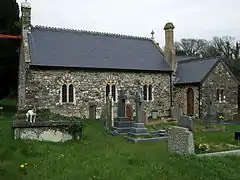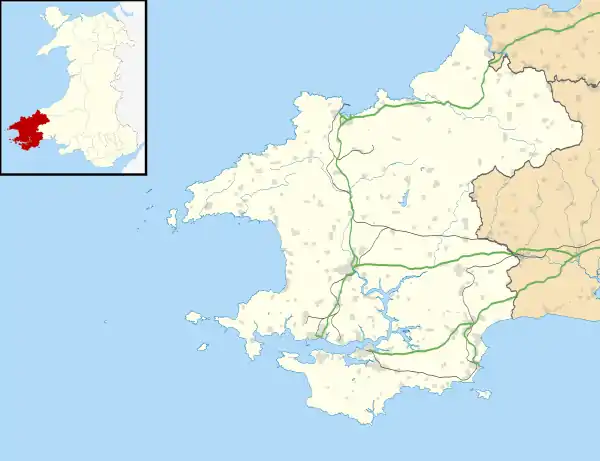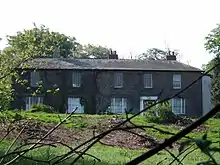Manorowen
Manorowen is a small settlement and parish on the A487 2 miles (3.2 km) southwest of Fishguard, Pembrokeshire, West Wales, in the Community of Scleddau; the parish includes the village of Scleddau—the eastern part of which is in the neighbouring parish of Llanstinan. A listed property bears the name of the parish, and the church is dedicated to St Mary.
| Manorowen | |
|---|---|
 South aspect of St Mary's Church | |
 Manorowen Location within Pembrokeshire | |
| OS grid reference | SM9336 |
| Community | |
| Principal area | |
| Ceremonial county | |
| Country | Wales |
| Sovereign state | United Kingdom |
| Postcode district | SA65 |
| Police | Dyfed-Powys |
| Fire | Mid and West Wales |
| Ambulance | Welsh |
| UK Parliament | |
| Senedd Cymru – Welsh Parliament | |
History
The origin of the parish name is obscure because there have been many different spellings throughout history, including Maenor Owain, Manerowen, Manorawen and Manernawen, but the earliest recorded document is dated 1453.[1] It is marked as Manerowen on a 1583 parish map of Pembrokeshire.[2]
In 1688 John Lewis Esquire of Manernawen (sic) was appointed Commissioner for Haverfordwest under an act to collect money for a royal grant.[3]
The parish church of St Mary is 19th century with later additions, but contains a memorial dated about 1670; the oldest gravestone is about 1791.[4][5] The church was closed for a time following a bat infestation, but remedial work resulted in its reopening in 2015.[6]

Manorowen is the name of an estate, whose house, walled garden and gazebo are Grade II listed.[7] The present house dates from about 1830.[5][8][9] According to the charity Parks and Gardens, the site was first created between 1650 and 1699,[10] and was recorded by Richard Fenton as belonging to his great grandfather John Lewis (see above) in the late 17th century when it was called Manarnawen.[8]
Lewis's 1833 Topographical Dictionary of Wales notes Manorowen (or Maenor-Owain) as being a small parish[11] in the Hundred of Dewisland, with 220 inhabitants.[12]
From 1913 until 2004, there was a school at Manorowen. The school's log books, admission register, photographs and miscellaneous papers are held at the Pembrokeshire Archives.[13]
Notable people
David Jones, vicar of Llangan and an early supporter of Welsh Calvinistic Methodism, lived in Manorowen and Richard Fenton (1747-1821) is buried there.
References
- "British History Online: Parliament Rolls: Henry VI". Retrieved 27 February 2018.
- "Penbrok comitat". British Library.
- "British History Online:William and Mary, 1688: An Act..." Retrieved 27 February 2018.
- "Coflein: St Mary's Church, Manorowen". Retrieved 28 February 2018.
- Lloyd, T., Orbach, J., Scourfield,R. (2004). Pembrokeshire. Yale University Press. pp. 279–280. ISBN 9780300101782. Retrieved 28 February 2018.CS1 maint: multiple names: authors list (link)
- Open for worship (PDF). Pobl Dewi. St Davids Diocese. 1 June 2016. p. 9. Retrieved 28 February 2018.
- "British Listed Buildings: Manorowen". Retrieved 27 February 2018.
- "Coflein: Manorowen" (PDF). Retrieved 27 February 2018.
- Cadw. "Manorowen (Grade II) (13029)". National Historic Assets of Wales. Retrieved 12 August 2019.
- "Parks and Gardens: Manorowen". Retrieved 27 February 2018.
- "GENUKI: Manorowen Parish Map". Retrieved 26 February 2018.
- "GENUKI: Manorowen". Retrieved 26 February 2018.
- "National Archives: Manorowen School". Retrieved 27 February 2018.
External links
| Wikimedia Commons has media related to Manorowen. |
